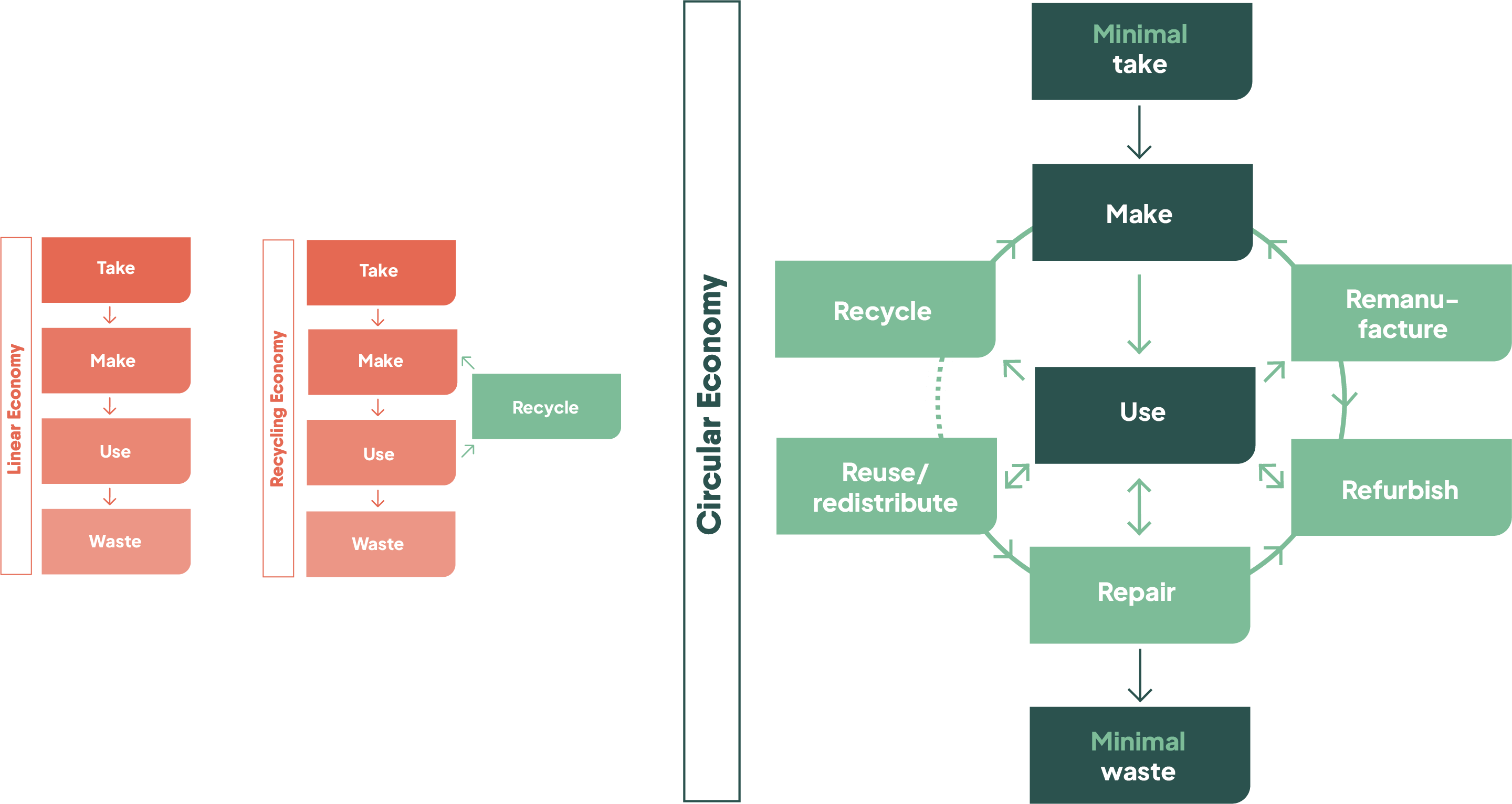What is circular economy?

Circular Economy - ever heard of it?
What is your first thought when you think of Circular Economy? Most people will probably first think of sustainable waste management and recycling. That's right, but Circular Economy goes one step further.
For all companies, from brick-and-mortar retail to online trading to corporations as global players, sustainability is an increasingly important principle of action for the use of resources. One, and indeed the decisive prerequisite for lasting sustainability is the Circular Economy - it is considered THE economic model of the future. But what is that exactly?
Circular economy in a nutshell.
As the term Circular Economy already suggests, the aim is to keep all the materials and substances used within the value chain as far as possible in a cycle. The value-added chain ranges from manufacturing and production to the distribution and consumption of economic goods to their recycling after their useful life has expired. In addition, hazardous and dirty waste should be reduced to a minimum. Forward-looking thinking is the motto here: Ideally, it is already ensured in the production stage that the subsequent material recovery is actually feasible under scientific and technological premises.
In short: The ultimate goal of a Circular Economy is to create an economy in which resources are used but not consumed.
For an even better understanding, a small digression on the beginnings of the Circular Economy:
How did it all come about?
There are basically three different types of economy. It starts with the classic Linear Economy. This principle is very simple: products are made, used, and then thrown away. Then there is a second form of Linear Economy, modified somewhat with the addition of recycling. Let's call it the Recycling Economy here. In this form, the basic structure is the same as the classic Linear Economy, but some reuse is added and some waste is avoided. The third form, the Circular Economy, goes even further: In contrast to the Linear and Recycling Economy, this creates a virtually endless cycle of use that includes manufacture, return, repair, refurbishment, reuse and, of course, recycling. The Circular Economy, therefore, considers the entire life cycle of the materials used.

What are the advantages of Circular Economy?
- Tackling the causes of global warming by drastically reducing greenhouse gas emissions by avoiding waste and pollution
- Avoiding high resource consumption by consistently reusing resources and maximizing lifetime-use
- Combating climate change, water scarcity, soil degradation and biodiversity loss
- Separation of economic growth from the consumption of natural resources
- Creation of new jobs
- Creation of new business models that are both sustainable and competitive
What role does insurance play within Circular Economy?
The focus of Circular Economy is usually on manufacturing or the manufacturing industry. But insurance companies can also play a major role in establishing a Circular Economy. Keyword: claims settlement.
Insurance providers should integrate the principle of "repair instead of replace" into their claims settlement. In this way, they can also help to ensure that resource-saving repairs are used rather than generally providing replacements. Provided, of course, that a repair is still possible. The same applies to remanufacturing and refurbish offers.
What's more? Insurance solutions can be integrated into a rental, sharing and general consumer offering. This makes the use of rental and sharing offers even more attractive for customers and can lead to higher usage.
So as you can see, insurance companies also have the opportunity to contribute to a Circular Economy and thus to a more sustainable economy through the measures mentioned above. But how do retailers and manufacturers benefit from the integration of such insurance solutions?
These are the advantages for retailers and manufacturers
- Increase in customer trust
- Upsell opportunities through the integration of insurance
- Strengthen your own brand
- Differentiation from competition
- You make a contribution to the environment and counteract the "throw-away society".
Why should we now concern ourselves with Circular Economy?
In principle, Circular Economy draws partly on a well-established tradition. Even before that, economies were predominantly circular - trade was conducted and consumed locally, and goods were reused due to scarcity. Waste of resources was kept to a minimum. This is exactly where Circular Economy wants to start. It thus solves a modern problem by going back to an old model.
Let's assume that by 2030 the circular economy will have completely replaced the linear and recycling economy and will therefore exist as the only form of economy. Companies that have ignored the issue around Circular Economy by then will have difficulty in remaining competitive.
So is Circular Economy a myth? We definitely say no. Certainly, a little more "spreading information" is needed, but the enormous potential that circular economy offers for companies should not be underestimated.
Get in touch
Would you like to know how hepster is boosting the circular economy? We will be happy to explain it to you.


